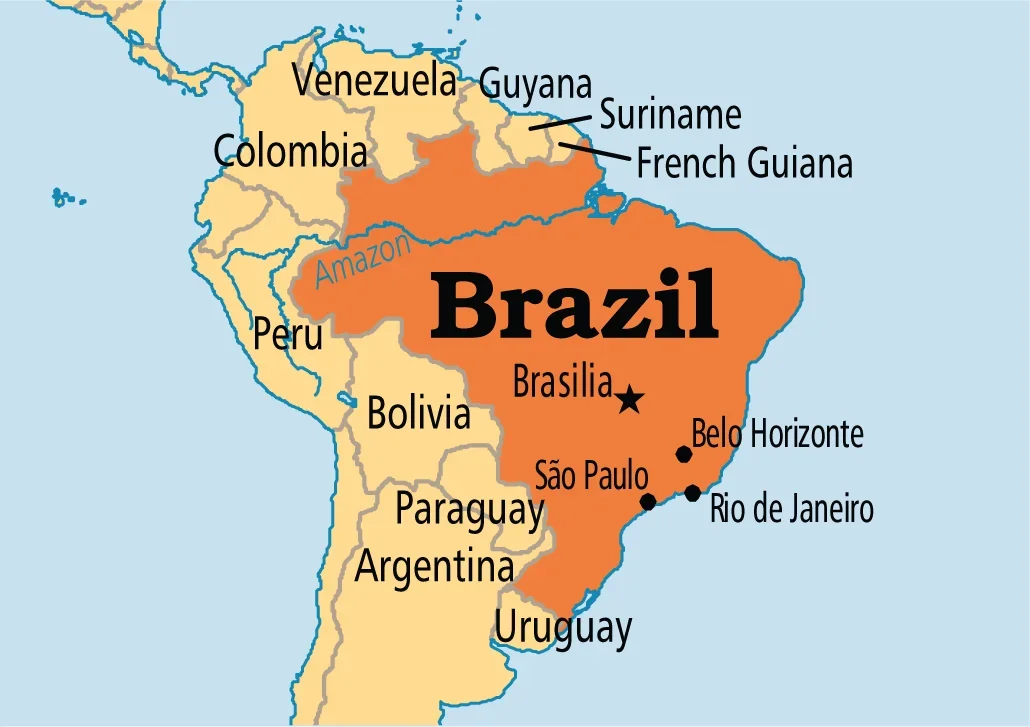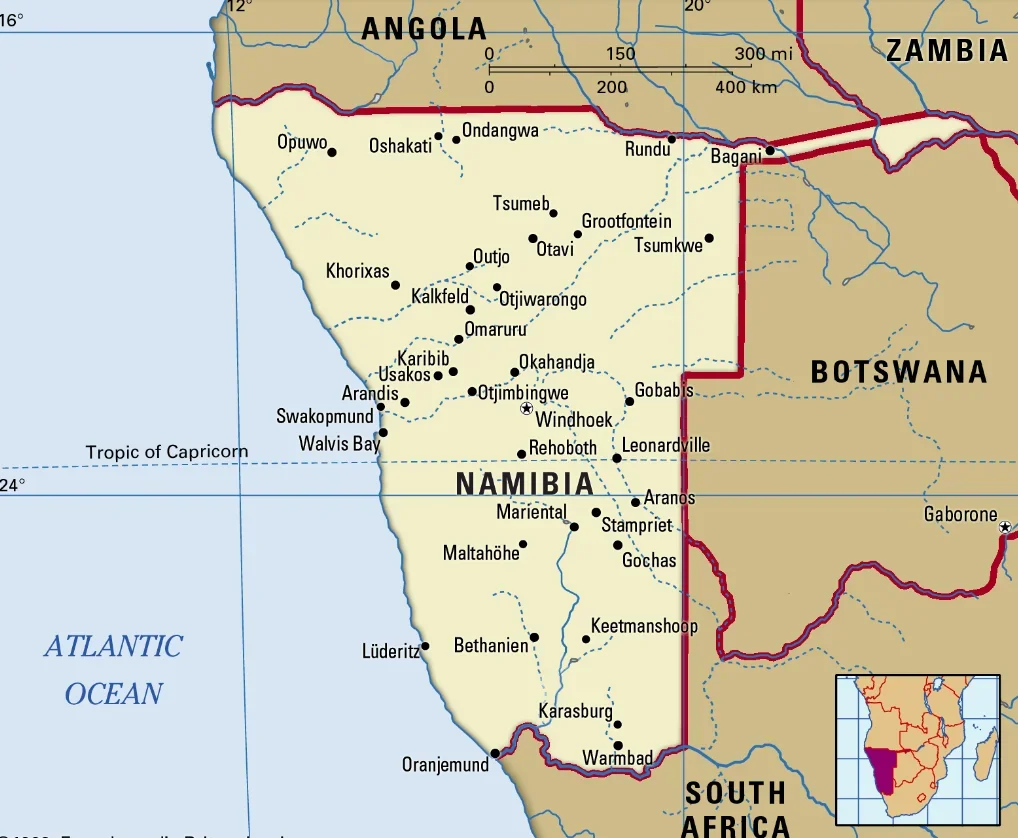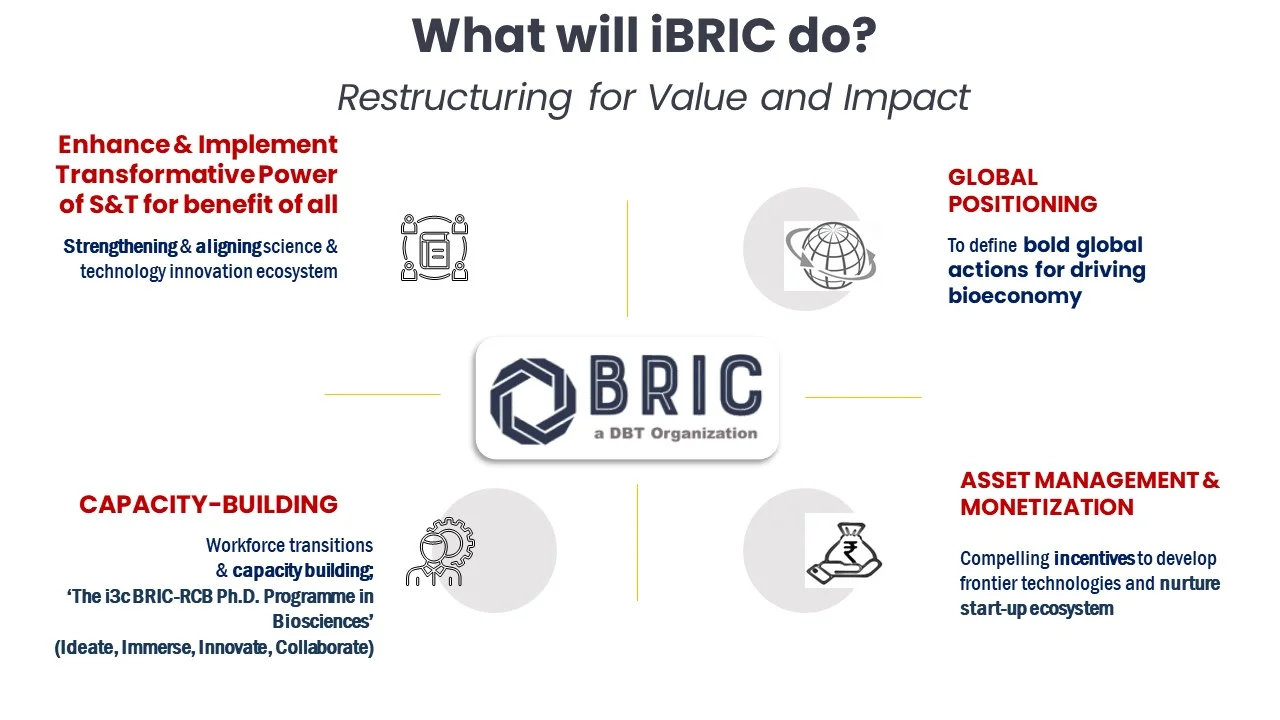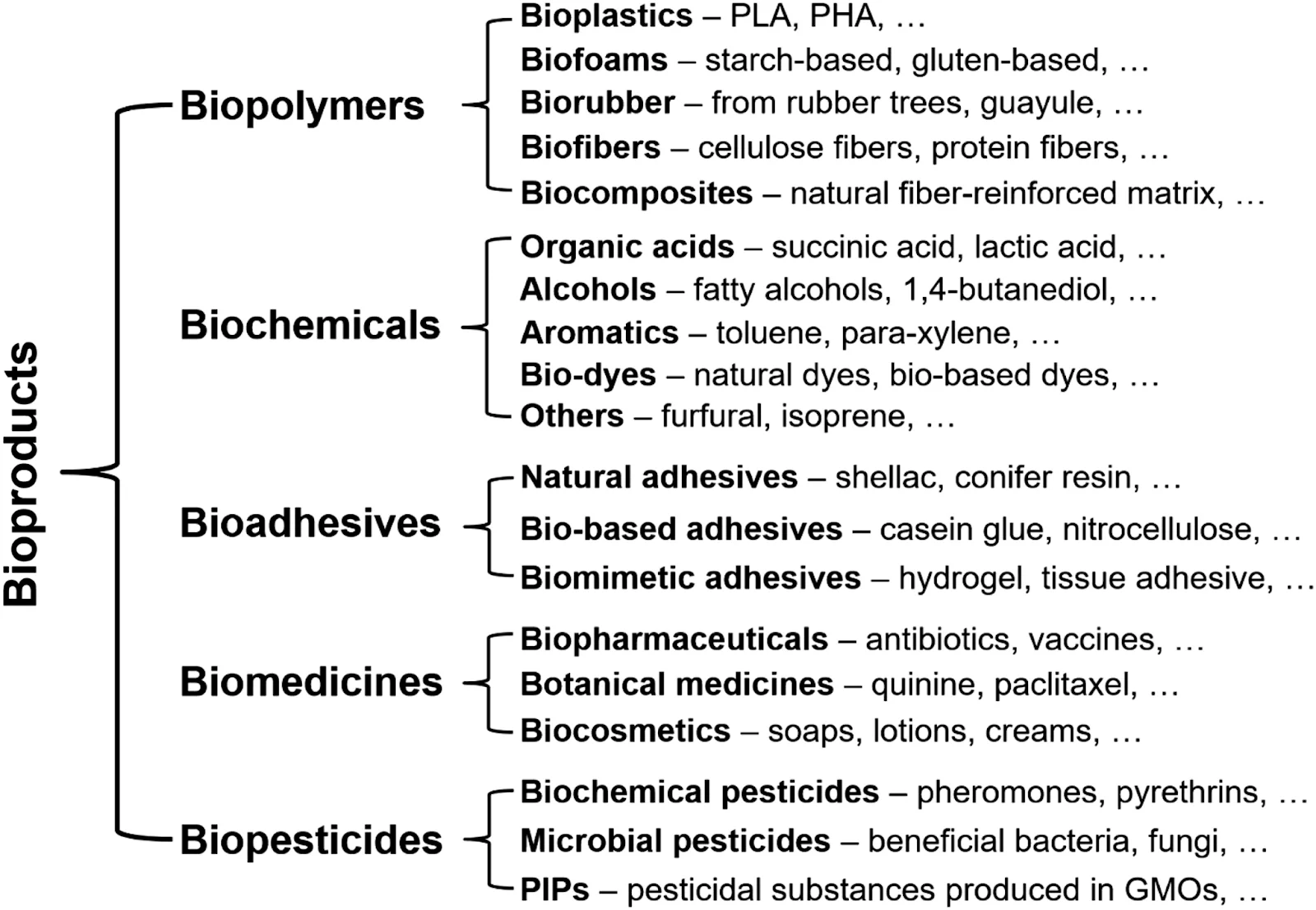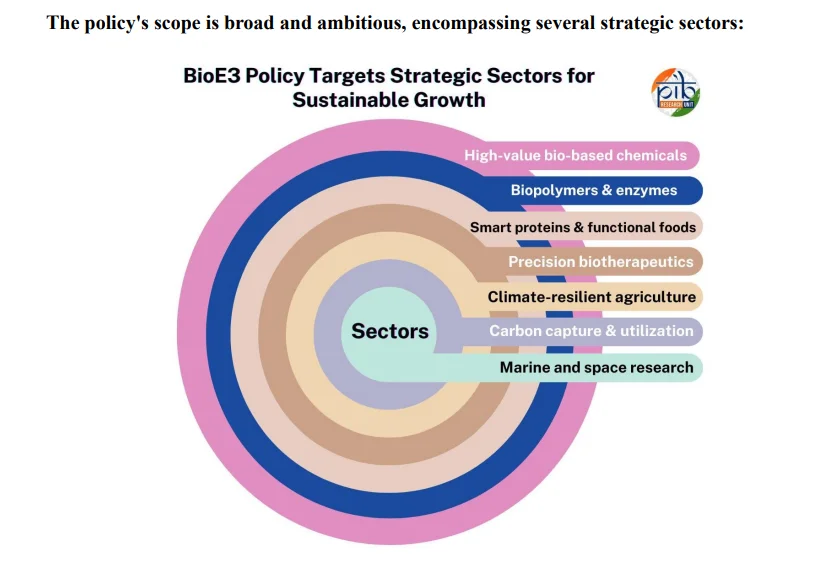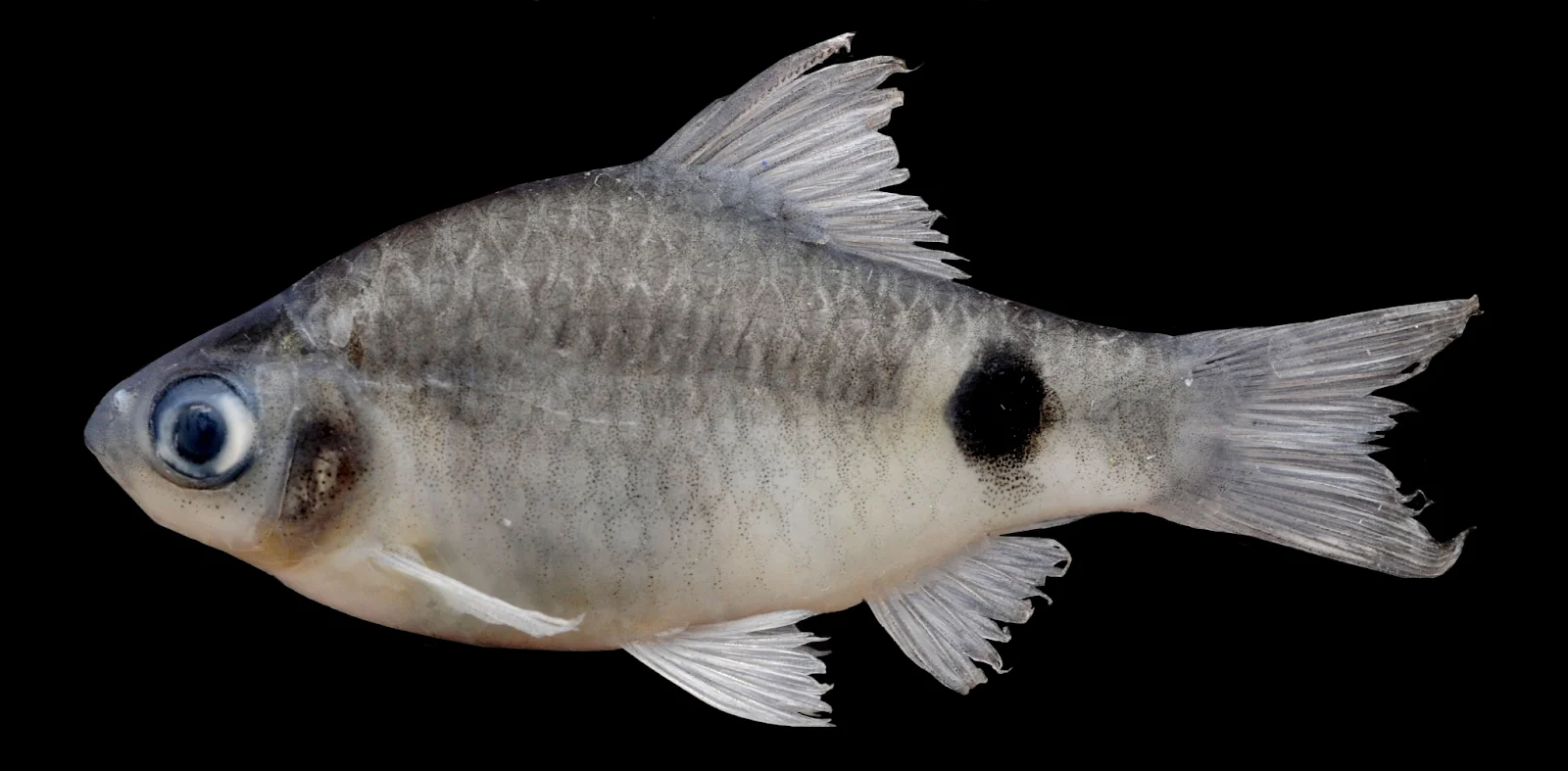Urban Centres as Catalysts of India's Growth
For Prelims: Gross Domestic Product, Asian Development Bank, Biomass, Sustainable Development Goal
For Mains: Urbanisation and associated challenges in India, Role of cities in India’s economic growth
Why in News?
India is undergoing a rapid urban transformation, with the urban population expected to reach 675 million by 2035 and 70 million more residents by 2045. This rapid urbanization will shape the economic and social trajectory of India for decades to come.
- However, urban challenges in Indian Cities continue to hinder the full potential of this transformation.
Why are Cities Central to India’s Economic Future?
- Economic Engines: Cities contribute nearly 60% of India’s Gross Domestic Product (GDP) while occupying only 3% of land, highlighting their role as hubs of productivity and innovation.
- Just 15 cities including Mumbai, Delhi, Bengaluru, Chennai, and Hyderabad account for 30% of India’s GDP. These cities are expected to contribute an additional 1.5% to GDP growth by 2047.
- Agglomeration Benefits: Higher population densities in urban centres lead to greater economic output, better job creation, and innovation through clustering of industries and services.
- India’s growing urban population is anticipated to increase its economic productivity by an additional 1.5% annually, thereby facilitating substantial growth in national output.
- Global Competitiveness: Well-functioning cities improve ease of doing business, attract foreign investment, and support India's ambitions to become a USD 5 trillion economy by 2026 and USD 40 trillion by 2047.
- Infrastructure Efficiency: Urban areas with efficient transport, housing, energy, and logistics systems lower operational costs and boost industrial growth.
- Innovation Hubs: Cities foster startups, R&D, and technology adoption, becoming centres of digital and service-sector transformation.
- Social Opportunity: Urbanisation offers pathways for poverty reduction, education, and healthcare access, linking economic development with improved human development outcomes.
What are the Challenges Faced by Urban India?
- Congestion and Traffic Management: Urban residents spend an average of 1.5-2 hours daily stuck in traffic. This congestion increases pollution, wastes time, and hampers productivity.
- Most Indian cities lack comprehensive, efficient, and integrated public transport systems. This results in over-dependence on private vehicles, which further exacerbates traffic congestion.
- Eg. Jharkhand’s capital Ranchi has only 41 buses for a population of 1.46 million.
- According to the Asian Development Bank, India loses up to USD 22 billion annually due to urban transport inefficiencies, logistics delays, and poor infrastructure.
- Most Indian cities lack comprehensive, efficient, and integrated public transport systems. This results in over-dependence on private vehicles, which further exacerbates traffic congestion.
- Air Pollution: In 2023, India was home to 42 of the 50 most polluted cities in the world, up from 39 in 2022. The primary contributors to poor air quality include vehicular emissions, construction dust, and biomass burning.
- Poor air quality leads to respiratory diseases, affecting millions of urban residents, especially in cities like Delhi, Mumbai, and Bengaluru.
- Water Scarcity: Nearly half of India’s rivers are polluted, leading to inadequate water availability for urban areas. Inadequate treatment and wastewater management further strain water resources.
- Cities lose up to 40-50% of piped water in transmission due to outdated infrastructure, exacerbating water scarcity.
- Solid Waste Management: Indian cities generate over 150,000 tonnes of solid waste daily, but only a small portion is processed sustainably. Many cities lack effective waste segregation and recycling systems.
- Poor waste management contributes to pollution, health hazards, and unclean urban environments, making cities less livable.
- Inadequate Sanitation: Many urban areas, particularly informal settlements, lack access to proper sanitation facilities.
- Inadequate sewage systems and sewage leakages into water bodies continue to be a challenge in many cities.
- Affordable Housing Shortage: India faces a shortage of 10 million affordable homes, a number expected to triple by 2030. The urban poor often live in informal settlements or slums, which lack basic infrastructure like clean water, sanitation, and electricity.
- This growing shortage not only leads to overcrowded slums but also creates urban ghettos, raising security challenges and increasing the potential for communal or religious violence.
- Additionally, the increasing demand for urban space drives property prices up, making affordable housing inaccessible to many.
- Urban Flooding: Many cities face urban flooding due to inadequate drainage systems, encroachment of stormwater drains, and rapid urbanization.
- The 2018 floods in Kerala and the 2015 floods in Chennai are prime examples of how urban infrastructure struggles to cope with extreme weather events.
- Weak Municipal Finances: Most Indian cities struggle to generate sufficient revenue through local taxes and municipal bonds. Less than 0.2% of India’s GDP (1.1% in the OECD) is raised through property taxes.
- Many cities rely on central government funding for urban development projects, but the funds allocated are often insufficient or inefficiently utilized.
- Digital Infrastructure Deficits: India’s internet speed is much lower compared to cities in countries like Singapore, Hong Kong, and Seoul.
- This hampers the growth of digital businesses and slows down overall economic growth.
- Urban Heat Island: Higher temperatures lead to increased use of air conditioning, raising electricity demand, especially during peak summer. This burdens urban power grids and increases carbon emissions.
- Urban Heat Islands increase health risks for vulnerable groups, reduce green cover and biodiversity, strain water resources, raise flood risk, and degrade infrastructure and urban livability.
What are India's Initiatives for Promoting Growth and Sustainability in the Urban Sector?
What Reforms are Needed for India's Urban Future?
- Treat Urban Infrastructure as Core National Infrastructure: Elevate urban infrastructure (mobility, water, sanitation, waste) to the same level as highways, ports, and energy grids.
- Classify smart cities and logistics ecosystems as “strategic infrastructure” to attract long-term capital and policy alignment.
- Synchronise Urban Expansion with Industrial Corridors: Bridge the disconnect between housing, commerce, and transport (Transit-Oriented Development). Promote spatial integration of transit, zoning, and economic planning to create compact, liveable, and productive urban-industrial zones.
- Create Unified, Tech-Enabled Urban Governance Bodies: Streamlining urban planning and approvals is essential. Urban Governance Bodies must embed private sector leadership and work alongside public authorities to improve accountability.
- Real-time performance dashboards and urban digital twins (a dynamic digital replica of a city, integrating advanced technologies to provide actionable insights) can ensure more responsive and transparent management of urban systems.
- Treat Sanitation and Waste Management as National Economic Priorities: Sanitation and waste management are economic issues.
- Private sector models, like the Tirupur water PPP, using the BOOT model, successfully delivered water to industries and residents. Similar industry-led models can be extended to waste management, circular economy, and decentralized sanitation.
- Recapitalize Public-Private Partnerships (PPPs): In today’s urban reality, PPPs must be redefined to ensure long-term private capital flows into both existing infrastructure (brownfield) upgrades and new urban projects (greenfield).
- De-risking instruments like viability gap funding and urban challenge funds can facilitate such investments.
- Co-Develop the Digital Backbone of Modern Cities: Industry should collaborate with the government to build the digital backbone of cities, such as AI-powered infrastructure planning and automated construction permits.
- This digital infrastructure can improve efficiency, transparency, and trust while accelerating urban development.
- Strengthening Climate Resilience in Cities: Urban planning must integrate climate resilience by building adaptive infrastructure like flood barriers and heat-resistant structures. Measures such as green roofs, urban forestry, and green spaces help mitigate heat islands and enhance urban livability.
- Role of Society in Urban Reform: Urban reform is not just about improving systems but also about engaging society. Reforms must be co-created with citizens and industry alike.
- Participatory frameworks that blend policy, people, and private capital are essential to ensuring the resilience and legitimacy of cities. These collaborations can empower cities to meet local needs while contributing to national progress.
Conclusion
Indian cities are vital drivers of regional growth but face challenges in infrastructure, sustainability, and governance. Sustainable urban planning, improved public transport, and resource management are key to promoting Sustainable Development Goal (SDG) 11 (Sustainable Cities), SDG 13 (Climate Action), and SDG 10 (Reducing Inequalities), ensuring equitable urban development.
|
Drishti Mains Question: Urbanisation is both an opportunity and a challenge for India. Discuss |
UPSC Civil Services Examination Previous Year’s Question (PYQs)
Mains
Q. The frequency of urban floods due to high intensity rainfall is increasing over the years. Discussing the reasons for urban floods, highlight the mechanisms for preparedness to reduce the risk during such events. (2016)
Q. Do government schemes for up-lifting vulnerable and backward communities by protecting required social resources for them, lead to their exclusion in establishing businesses in urban economies? (2014)
Legislative Productivity in India
For Prelims: Office of Speaker of Lok Sabha, Lok Sabha, Productivity of parliament, Adjournment, Parliamentary Committees, Rajya Sabha
For Mains: Issues Related to Functioning of Parliament & Measures to Improve Productivity of Parliament
Why in News?
Lok Sabha Speaker, while speaking at the National Conference of Urban Local Bodies (ULBs) Chairpersons highlighted the need to enhance legislative productivity and discourse quality.
What is the Status of Legislative Productivity in India?
- About: Legislative Productivity refers to the efficiency and effectiveness with which legislative bodies such as the Parliament and State Legislatures carry out their core functions such as lawmaking, executive oversight, budget approval, and debate on issues of national/public importance.
- Status:
- Number of Sitting Days: Parliament's sitting days have declined from around 135 days/year in the 1st Lok Sabha to just around 55 days/year in the 17th Lok Sabha.
- Length of Each Sitting: Longer sittings are essential for in-depth legislative deliberation. However, in the 2023 Budget Session, Lok Sabha and Rajya Sabha functioned for only 33% and 24% of scheduled time respectively, making it the 6th shortest Budget Session since 1952.
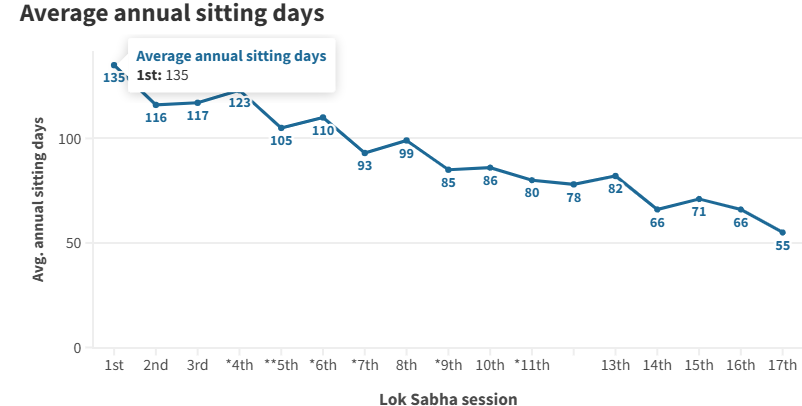
- Number of Members Present: A strong quorum is vital for meaningful debate and informed decision-making. In the 17th Lok Sabha (2019–2024), average MP attendance was 79%, but debate participation remained low, with MPs averaging only 45 debates each.
- Level of Disruption: Frequent disruptions, such as slogan shouting and walkouts, drastically reduce debate time. The 15th Lok Sabha (2009–14) lost over 30% of its scheduled time to disruptions, severely affecting legislative productivity.
- Examination by Parliamentary Committees: In the 17th Lok Sabha, only 10% of Bills were referred to committees, a sharp drop from the 14th LS (60%), 15th (71%), and 16th (25%), with just 14 Bills reviewed. Additionally, increasing party-line divisions within committees in recent years have undermined bipartisan scrutiny, affecting the quality of legislative review.
- Functioning of Debates: Question Hour & Zero Hour, essential tools for executive accountability, remain underutilized or absent. In the 17th Lok Sabha, Question Hour functioned for only 19% of scheduled time in Lok Sabha and 9% in Rajya Sabha.
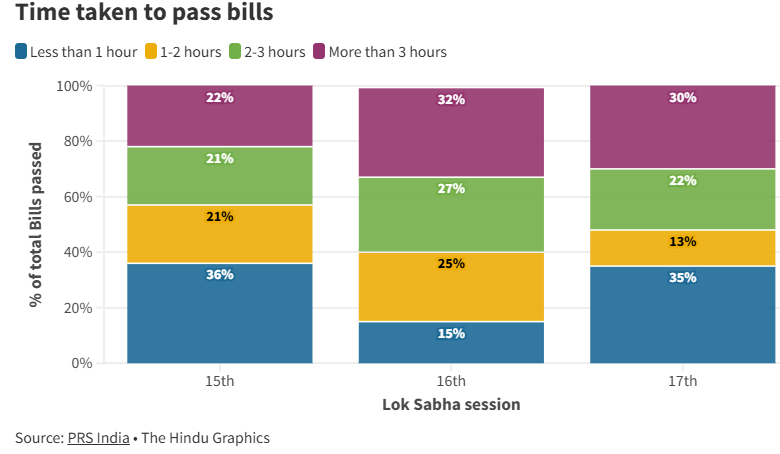
- Introduction of Private Member Bills: Since Independence, over 300 such Bills have been introduced, but only 14 have been passed, with the last one in 1970.
- Delayed Constitutional Requirements: The Deputy Speaker post under Article 93 has remained vacant throughout the 17th Lok Sabha, despite the constitutional requirement of election “as soon as possible.”
- Decline in Consensus-Driven Lawmaking: The tradition of building consensus between the government and the Opposition has weakened significantly, leading to the passage of key Bills with minimal debate and frequent disruptions.
- The limited use of joint sittings, only 3 times since 1950, highlights the erosion of mechanisms meant to resolve legislative deadlocks.
What are the Key Implications of Lower Productivity of Legislature?
- Oversight Weakening: Fewer sitting days, frequent disruptions, and underutilized Question Hour reduce the legislature’s ability to hold the executive accountable, weakening parliamentary scrutiny and enabling unchecked decision-making.
- Poor-Quality Lawmaking: Bypassing Parliamentary Committees and passing Bills in haste often without debate, compromises the rigour, legality, and effectiveness of legislation, increasing the risk of judicial review and implementation challenges.
- Opposition Marginalisation: Limited time for debates, absence of Private Member Bills, and curbed Opposition participation dilute inclusive lawmaking, hinder consensus-building, and weaken the role of dissent in a democracy.
- Public Trust Erosion: Perceived legislative dysfunction undermines citizen confidence in democratic institutions, leading to political apathy, reduced electoral participation, and erosion of institutional legitimacy.
- Executive Overreach: Reduced legislative engagement enables the executive to bypass the legislature through ordinances, delegated legislation, and executive orders, upsetting the constitutional balance of power and weakening checks and balances.
What Measures Have Been Taken to Improve Legislative Productivity in India?
- Code of Conduct for MPs: A formal code of conduct guides the behavior of Members of Parliament (MPs), aiming to uphold decorum, reduce disruptions, and promote constructive participation in legislative business.
- Adoption of Technology: Parliament has adopted digital tools to enhance legislative efficiency. Live streaming of proceedings has increased public scrutiny, promoting greater accountability and disciplined behavior by MPs.
- Initiatives like e-Vidhan (NeVA) aim to make all State Legislatures paperless, ensuring real-time updates and improved transparency in legislative functioning.
- Strengthening the Committee System: A robust system of parliamentary committees, including Departmentally Related Standing Committees, is used to examine Bills, policies, and executive actions in detail.
- This allows for incorporation of expert input and strengthens the quality and depth of legislative deliberations.
- Disciplinary Mechanisms: To address unruly behavior, Parliament enforces disciplinary actions such as suspension or expulsion of MPs who violate rules. These measures aim to uphold the dignity of the House and ensure orderly functioning.
- Capacity Building for Legislators: Training sessions, workshops, and handbooks conducted by bodies like the Lok Sabha Secretariat, PRS Legislative Research, and NGOs equip Legislators with knowledge of procedures and best practices.
What Steps Can be Taken to Improve the Legislative Productivity in India?
- Institutional Discipline and Regular Functioning: Mandate minimum sitting days for Parliament and publish annual legislative calendars to ensure predictability and time-bound deliberation.
- Adopt Model Rules of Procedure across all tiers to standardize conduct and uphold legislative decorum.
- Committees & Legislative Scrutiny: Empower Standing and Subject Committees at all levels to examine Bills, budgets, and policies thoroughly.
- Make committee referrals mandatory for significant legislation. Institutionalize pre-legislative consultations to incorporate expert and stakeholder input early in the lawmaking process.
- Accountability and Transparency: Monitor and publish attendance, debate participation, and voting records of MPs, use the Right to Information (RTI) Act, 2005 for better accountability.
- Empower Presiding Officers to curb disruptions through disciplinary powers. Mandate live streaming and archiving of proceedings to enhance transparency and public trust.
- Dialogue and Capacity Building: Foster a shift from disruption to dialogue by encouraging consensus-building between the government and opposition.
- Provide training and orientation to first-time representatives to improve legislative quality and informed participation.
- Citizen Engagement and Recognition: Promote youth leadership rooted in integrity and public service. Recognize high-performing legislators through awards, grants, and platforms like the Manesar Conference to share best practices.
- Adopt International Best Practices: Adopt IPU (Inter-Parliamentary Union) standards promoting transparency, inclusivity, and access to legislative information.
- Emulate UK and German models of fixed sitting days and mandatory committee scrutiny.
- Introduce MP/MLA exchange programmes with countries like Canada, Australia, and the UK to share procedural and ethical best practices.
- Encourage benchmarking mechanisms inspired by OECD Parliaments, including public dashboards on legislative performance.
Conclusion
Legislative productivity is crucial for democratic accountability, quality lawmaking, and responsive governance. Despite advances in digital integration and committee reforms, issues like disruptions, low scrutiny, and reduced sittings hamper effectiveness. Strengthening institutional discipline, fostering bipartisan dialogue, and enhancing citizen participation are essential to empower legislatures at all levels for realizing Viksit Bharat @2047.
|
Drishti Mains Question: Analyse the key factors responsible for the decline in legislative productivity in India and propose holistic measures to strengthen it. |
UPSC Civil Services Examination, Previous Year Questions (PYQs)
Prelims
Q. Which of the following is/are the exclusive power(s) of Lok Sabha? (2022)
- To ratify the declaration of Emergency.
- To pass a motion of no-confidence against the Council of Ministers.
- To impeach the President of India.
Select the correct answer using the code given below:
(a) 1 and 2
(b) 2 only
(c) 1 and 3
(d) 3 only
Ans: B
Mains
Q. To what extent, in your view, the Parliament is able to ensure accountability of the executive in India? (2021)
Five Pillars for a Sustainable India-Brazil Relations
For Prelims: Biotechnology, Global Alliance Against Hunger and Poverty, Biofuels, Flex-fuel Vehicles, Global Biofuels Alliance, UNFCCC, Critical Minerals, International Solar Alliance (ISA), WTO, India-Mercosur Preferential Trade Agreement (PTA), GM Crops.
For Mains: Key areas of cooperation between India and Brazil, the challenges affecting their relationship, and the measures required to strengthen bilateral ties.
Why in News?
India’s Prime Minister paid a state visit to Brazil where both countries reaffirmed their commitment to deepening the India-Brazil Strategic Partnership, established in 2006 and agreed to enhance bilateral relations centered on five priority pillars.
- India’s Prime Minister was conferred Brazil’s highest state honour, the Grand Collar of the National Order of the Southern Cross.
Note: India’s Prime Minister arrived in Brasilia (capital of Brazil) after attending the 17th BRICS Summit 2025 (6th-7th July 2025) in Rio de Janeiro (Brazil).
- India will assume the BRICS Chairship and host the 18th BRICS Summit in 2026.
What are the Five Priority Pillars Agreed Upon to Enhance India- Brazil Bilateral Relations?
- Defense and Security Cooperation: India and Brazil signed agreements on the Exchange and Mutual Protection of Classified Information to deepen strategic cooperation, and on Combating International Terrorism and Transnational Organized Crime.
- They also launched a Cybersecurity Dialogue for information sharing.
- Food & Agricultural Security: India and Brazil stressed the urgent need for concrete action on sustainable agriculture, and ensuring food access, with plans for joint R&D in agricultural productivity, animal genetics, and biotechnology.
- They voiced opposition to trade barriers impacting food security, and affirmed support for the Global Alliance Against Hunger and Poverty.
- Energy Transition & Climate Action: India and Brazil emphasized the importance of sustainable biofuels and flex-fuel vehicles in decarbonizing transport and promoting sustainable development, while pledging to strengthen the Global Biofuels Alliance (GBA), of which both countries are founding members.
- India also extended support to Brazil’s UNFCCC COP30 Presidency (to be held in Belem, Brazil, November 2025) and the Tropical Forests Forever Fund.
- Digital Transformation and Emerging Technologies: Both countries agreed to convene the Joint Commission on Scientific and Technological Cooperation to enhance collaboration in key areas such as digital public infrastructure, artificial intelligence, quantum technologies, renewable energy, and outer space.
- Industrial Partnerships in Strategic Areas: India and Brazil identified key sectors for collaboration, including pharmaceuticals, mining and critical minerals, and oil & gas.
- They agreed to address non-tariff barriers, fast-tracking the enforcement of the Bilateral Investment Cooperation and Facilitation Treaty (2020) and and the Protocol amending the Convention for Avoidance of Double Taxation (2022), and launching a Brazil-India Business Council to strengthen private sector engagement.
What are the Key Highlights of India-Brazil Relations?
- Political & Diplomatic Ties: Diplomatic relations between India and Brazil were established in 1948, with India maintaining an embassy in Brasília and a Consulate General in Sao Paulo.
- The Strategic Partnership, established in 2006, has served to strengthen and deepen bilateral ties.
- Trade & Economic Engagement: Bilateral trade in 2024–25 stood at USD 12.2 billion with key Indian exports including petrochemicals, agrochemicals, pharma, and engineering goods, while Brazil exported crude oil, soy oil, sugar, gold, and iron ore to India.
- Indian investments in Brazil total around USD 6 billion whereas Brazilian investments in India are around USD 1 billion.
- Defense & Security Cooperation: The 2003 Defence Cooperation Agreement, ratified in 2006, established a Joint Defence Committee (JDC), and the 2+2 Political-Military Dialogue held its first meeting in 2024.
- Space & Technology Collaboration: India launched Brazil’s Amazonia-1 satellite in 2021 and Brazil is interested in India’s Digital Public Infrastructure (DPI).
- Energy & Biofuels Partnership: India and Brazil co-founded the Global Biofuels Alliance (2023), operate Joint Working Groups on Oil & Gas and Bioenergy, and Brazil ratified the International Solar Alliance (ISA) in 2022.
- Cultural & People-to-People Ties: India opened its first cultural centre in Latin America in Sao Paulo in May 2011, and Brazil hosts a vibrant Yoga and Ayurveda community.
- The Indian diaspora, estimated at around 4,000, consists primarily of professionals and businesspeople.
What are the Challenges in India-Brazil Relations?
- Limited Economic Diversification: Bilateral trade, at USD 12.2 billion in 2024–25, remains modest, constrained by non-tariff barriers such as strict sanitary, and phytosanitary, affecting agricultural trade.
- Trade is constrained by over-reliance on commodities, with Brazil exporting raw materials and India exporting refined products, leading to limited value-added trade.
- Geographical Distance: Trade competitiveness is reduced by high transportation costs and lengthy shipping routes, while connectivity bottlenecks and limited direct flights hinder business, tourism, and people-to-people exchanges.
- Competition in Agriculture & Biofuels: India and Brazil face rivalry in global sugar and ethanol markets, leading to competition over collaboration, while differences over subsidy policies, especially Brazil’s opposition to India’s sugar subsidies at the WTO, have caused friction.
- Cultural & Awareness Gaps: Cultural understanding remains limited, with Brazilians often associating India with yoga/spirituality and Indians viewing Brazil through football/carnival, compounded by limited media and academic exchanges between the two countries.
- Diverging Global Priorities: India and Brazil have different regional priorities—India focuses on the Indo-Pacific, while Brazil emphasizes Latin America.
- They also face multilateral alignment challenges, with divergent positions in WTO, and climate negotiations, particularly on agriculture subsidies and carbon emissions.
In What Ways can India-Brazil Relations be Strengthened Further?
- Boost Trade & Economic Engagement: Achieve bilateral trade target of USD 20 billion over the next 5 years by diversifying trade commodities and reducing non-tariff barriers through mutual recognition of pharma, food safety, and agricultural standards.
- Promote investments by encouraging Indian firms in Brazil and exploring an India-Mercosur Preferential Trade Agreement (PTA) expansion to cover more goods and services.
- Improve Logistics & Connectivity: Establish an India-Brazil maritime corridor to reduce shipping costs and time, and launch direct flights between Delhi/Mumbai and Sao Paulo to enhance tourism and business connectivity.
- Enhance Energy & Green Partnerships: Enhance collaboration on biofuels and ethanol by scaling up GBA projects and sharing India’s ethanol blending technology with Brazil’s sugarcane industry.
- Collaborate on critical minerals like lithium, cobalt, and rare earths to support India’s EV needs.
- Deepen Agricultural & Food Security Ties: India and Brazil should collaborate on developing GM crops and drought-resistant seeds, and promote joint ventures in organic food, vegan products, and ready-to-eat meals.
- Strengthen Institutional Mechanisms: Hold annual Prime Minister–President summits to strengthen ties, promote state-level partnerships through sister-city agreements (e.g., Mumbai–Rio, Bengaluru–Sao Paulo), and advance Track-II diplomacy via think tank collaborations.
Conclusion
India and Brazil strategic partnership, anchored in five key pillars, holds immense potential despite challenges like trade barriers and logistical gaps. By boosting economic ties, enhancing tech collaboration, and aligning global priorities, both nations can emerge as pivotal Global South leaders, fostering sustainable development and mutual growth in a multipolar world.
|
Drishti Mains Question: "India and Brazil share a strategic partnership, yet bilateral trade remains below potential." Discuss the challenges and suggest measures to enhance economic engagement. |
UPSC Civil Services Examination, Previous Year Question (PYQ)
Mains
Q. “The broader aims and objectives of WTO are to manage and promote international trade in the era of globalization. But the Doha round of negotiations seem doomed due to differences between the developed and the developing countries.” Discuss in the Indian perspective. (2016)
India-Namibia Relations and Africa
For Prelims: Namibia, Africa, Coalition for Disaster Resilient Infrastructure (CDRI), Global Biofuels Alliance, Indian Technical and Economic Cooperation Programme (ITEC), Preferential Trade Agreement (PTA), Southern African Customs Union (SACU), Necklace of Diamonds strategy, Democratic Republic of Congo, African Union, G20, WTO Intellectual Property, Pravasi Bharatiya Divas, IIT Madras Zanzibar.
For Mains: Key highlights of India-Namibia relations, Strategic significance of Africa for India, Key obstacles in effective India-Africa cooperation.
Why in News?
India’s Prime Minister undertook a State Visit to Namibia (1st by an Indian PM in 27 years), addressed the Namibian Parliament, and reaffirmed India’s commitment to a partnership with Africa rooted in dialogue rather than dominance.
- He was also conferred Namibia's highest civilian award – the Order of the Most Ancient Welwitschia Mirabilis – becoming the first Indian leader to receive this honour.
- Namibia submitted letters of acceptance to join the Coalition for Disaster Resilient Infrastructure (CDRI) and the Global Biofuels Alliance, and became the first country globally to sign a licensing agreement to adopt UPI technology.
Namibia
- Geographical Location: Namibia is a Southern African nation with its western boundary formed by the Atlantic Ocean.
- It shares its northern borders with Angola and Zambia, while Botswana lies to its east and South Africa borders both its eastern and southern regions.
- Climate: Namibia, acknowledged as the driest nation in sub-Saharan Africa, is home to several major deserts, including the Namib, the Kalahari, the Succulent Karoo, and the Nama Karoo.
- Colonial History: In 1884, the German Empire established colonial rule over much of the region, naming it German South West Africa.
- Important Rivers: Zambezi, Okavango, and Kunene are important rivers in Namibia.
Welwitschia Mirabilis
- About: Welwitschia mirabilis (national plant of Namibia) is a rare, ancient plant native to the Namib Desert in Namibia and southern Angola, often called a "living fossil" due to its remarkable longevity and unique features.
- Namibia's highest civilian award – the Order of the Most Ancient Welwitschia Mirabilis is named after this plant.
- Appearance: It has only two broad leaves that grow continuously, becoming twisted and tattered but never falling off. A woody stem and deep taproot help it endure arid conditions.
- Longevity: Some specimens are over 1,500 years old, making them among the oldest living plants.
- Habitat: Found only in the Namib Desert, it relies on Atlantic fog for moisture due to scarce rainfall.
- Many desert-dwelling animals, such as zebras, oryx, and black rhinoceros, feed on the leaves of Welwitschia as a vital source of water.
What are the Key Highlights of the India-Namibia Relations?
- Historical and Political Ties: India was among the first countries to raise Namibia’s independence at the United Nations in 1946, extended material and diplomatic support to South West Africa People’s Organisation (SWAPO led Namibia’s liberation struggle).
- Full diplomatic relations were established in 1990, while Namibia opened its resident Mission in New Delhi in March 1994.
- Cheetah Translocation Project: 8 cheetahs translocated from Namibia to India in 2022, marking the world’s first intercontinental translocation of a major carnivore species.
- Capacity Building & Defence Cooperation: India offers scholarships to Namibians under Indian Technical and Economic Cooperation Programme (ITEC), along with annual defence training slots.
- Since 1996, an IAF Technical Team has trained Namibian Air Force helicopter pilots, and India has provided 2 Chetak and 2 Cheetah helicopters.
- Development Assistance: India provided 30,000 Covishield doses to Namibia, and established the India-Namibia Centre of Excellence in IT (INCEIT) and an India Wing at the University of Namibia.
- Economic Relations: Bilateral trade stood at USD 568.40 million in 2024–25, with key sectors including mining, energy, agriculture, education, infrastructure, health, and trade.
- A Preferential Trade Agreement (PTA) is under negotiation between India and the Southern African Customs Union (SACU), with Namibia as coordinator.
- Indian Community in Namibia: Around 450 Indians/NRIs/PIOs reside in Namibia. The India-Namibia Chamber of Commerce and Industry (INCCI) and India-Namibia Friendship Association (INFA), established in 2016 and 2020 respectively, promote business and community engagement.
Why is Africa Strategically Important to India?
- Geopolitical and Maritime Safeguards: Africa’s geographical position at crossroads of the Indian and Atlantic Ocean is vital for securing India’s maritime trade routes and enhancing naval influence.
- India’s first overseas naval base in Mauritius (2024) under the Necklace of Diamonds strategy underscores efforts to safeguard sea lanes and counter piracy and terrorism.
- Rising Economic Power: India-Africa bilateral trade reached USD 98 billion in 2022–23, including USD 43 billion from mining and mineral sectors.
- The African Continental Free Trade Area (AfCFTA), operational from 2021, creates a single market of 1.4 billion people, boosting prospects for Indian exports and investments.
- Securing Critical Minerals: The Democratic Republic of Congo alone provides over 70% of the world’s cobalt, essential for EV batteries and renewables.
- Nigeria and Angola help meet India’s energy needs, with Africa’s share in India’s crude imports rising amid global supply volatility.
- Diplomatic Leverage: India’s successful push for the African Union’s permanent G20 membership in 2023 marked a diplomatic milestone, boosting Africa’s global economic role.
- Joint efforts at the WTO on intellectual property waivers for Covid-19 vaccines and agriculture reflect a shared commitment to equitable global governance, and enhancing India’s Global South leadership.
- Geopolitical Ally: With its 54 nations, Africa constitutes a powerful bloc in global forums, emerging as a key geopolitical partner for India, with mutual support for each other’s representation in the UN Security Council.
- As global power shifts, a strong India-Africa partnership serves to counterbalance regional powers like China.
- Strong Diaspora: The 3 million-strong Indian diaspora in Africa acts as a bridge between the two regions, having historically contributed to African economies.
- India is leveraging this link through initiatives like Pravasi Bharatiya Divas, which in 2019 focused on the African diaspora to boost economic and cultural ties.
What are the Key Obstacles in Deepening India-Africa Ties?
- Sluggish Investment Activity: Despite growing ties, Indian investments in Africa trail behind China and the West due to risk perception, limited market knowledge, and strong competition, limiting India’s economic influence.
- Credibility Issues with Indian Exports: A persistent perception in some African markets views Indian products as lower in quality compared to Western or Chinese alternatives, affecting sectors like pharmaceuticals and machinery.
- The 2022 tainted syrup incident in Gambia, which caused over 60 child deaths, further hurt India’s reputation and market share.
- Diplomatic Dilemma: India’s Africa engagement has been criticized for over-focusing on East and Southern Africa, with less attention to other regions.
- In 2022–23, exports to South Africa alone reached USD 8.47 billion, while West Africa, despite its economic potential, remains under-engaged, risking missed opportunities.
- Complex Security Landscape: Africa’s security crises, marked by 9 coups (2020–2023) and armed conflicts, along with weak governance and rising radicalization, hinder India’s security and economic partnerships with Africa.
- Resource Competition: India–China competition for African oil and gas has heightened tensions, leading to inflated prices and diplomatic strain as African nations balance ties with both Asian powers.
- E.g., in 2006, India lost a bid for oil assets in Angola to China.
What Steps Should India Take to Deepen Engagement with Africa?
- Revamping of Trade Frameworks: India should forge economic partnerships with AfCFTA, offering preferential access to coffee, cocoa, and rare earths in exchange for greater market access for Indian pharmaceuticals and IT services.
- Strategic Dialogue Framework: India should establish an annual India-Africa Strategic Partnership Forum to enable joint agenda setting and swift responses to challenges like food security and climate resilience.
- Countering Neo-Colonialism: India can help African nations counter neo-colonialism by promoting economic, political, and technological self-reliance e.g., offering technical assistance to print currency locally.
- More than 40 African nations, such as South Sudan, Tanzania, and Mauritania, continue to print their currency in the UK, France, and Germany.
- Innovation-Driven Capacity Building: India can set up innovation hubs and R&D centers in key African nations focused on agri-tech, renewable energy, digital governance, and healthcare, leveraging the IIT Madras Zanzibar (2023) model.
- Deepen Security Partnerships: India should deepen engagement with African Union security frameworks by offering specialized training at the UN Peacekeeping Centre in New Delhi and expanding intelligence sharing and cybersecurity collaboration.
- Infrastructure Impetus: India should establish an India-Africa Infrastructure Commission to fast-track high-impact projects like solar power, water treatment, and digital connectivity, with clear timelines and accountability.
Conclusion
India-Namibia and India-Africa relations reflect a strong foundation of historical solidarity, strategic cooperation, and shared development goals. India’s broader Africa engagement, though promising, requires strategic recalibration to address investment gaps, regional imbalances, and growing competition. Strengthened dialogue, innovation-led capacity building, and inclusive trade frameworks can elevate India-Africa ties to new heights.
|
Drishti Mains Question: Critically analyze the challenges India faces in deepening its engagement with African countries. |
UPSC Civil Services Examination, Previous Year Questions (PYQs)
Prelims
Q. In which one of the following groups are all the four countries members of G20? (2020)
(a) Argentina, Mexico, South Africa and Turkey
(b) Australia, Canada, Malaysia and New Zealand
(c) Brazil, Iran, Saudi Arabia and Vietnam
(d) Indonesia, Japan, Singapore and South Korea
Ans: (a)
Mains
Q. ‘The long-sustained image of India as a leader of the oppressed and marginalised nations has disappeared on account of its new found role in the emerging global order.’ Elaborate. (2019)
World Bioproduct Day 2025 and BioE3 Policy
Why in News?
The Department of Science & Technology (DST), along with BIRAC and iBRIC+, organized World Bioproduct Day 2025, focusing on Equity, Environment, and Economy to highlight the importance of inclusive public participation in biotechnology.
- The event also reiterated the government's goal of achieving a USD 300 billion bioeconomy by 2030 under the BioE3 framework.
World Bioproduct Day
- Launched in 2021 by the World Bioeconomy Forum, the day aims to promote awareness about the potential of bio-based products in advancing environmental sustainability, climate action, and green innovation by reducing dependence on fossil fuels.
iBRIC+
- iBRIC+ (Indian Bioeconomy Research and Innovation Consortium Plus) is a strategic initiative by the Department of Biotechnology (DBT) aimed at accelerating India’s bioeconomy through a collaborative, multi-stakeholder platform.
- Building on the iBRIC foundation, it expands focus to strengthen regional innovation ecosystems and support a sustainable, high-performing bioeconomy.
- It complements BRIC, which integrates 13 DBT institutions under one framework to improve governance, ensure HR parity, promote NEP-aligned research, enable interdisciplinary collaboration, and align R&D with national missions for enhanced socio-economic impact.
What are Bioproducts?
- About: Bioproducts are fuels, materials, and chemicals made from renewable biomass like crops, trees, algae, and agricultural waste.
- Eg: Biofuels (ethanol, biogas), bioplastics, bio-based cosmetics, and plant-derived medicines.
- Significance: Bioproducts reduce reliance on fossil fuels, thereby addressing air pollution, deforestation, and biodiversity loss.
- Through biotechnological innovation, they promote climate-resilient development without compromising product quality or performance.
- Categories of Bioproducts:
- Production Methods: Bioproducts are produced using methods such as fermentation, pyrolysis, enzymatic conversion, and chemical synthesis.
- Biodegradability: Not all bioproducts are biodegradable and it depends on the intended use (e.g., bio-based paint is not biodegradable).
- Feedstocks & Sustainability: Common sources include soybeans, corn, sugarcane, sunflowers, flax, potatoes, algae, and mycelium.
- Many bioproducts use agricultural or forestry waste, minimizing pressure on food supply. For example, sunflower residue after seed removal can be converted into biofuel.
What is the BioE3 Policy?
- About: The BioE3 Policy (Biotechnology for Economy, Environment, and Employment), launched by the Department of Biotechnology in 2024 to promote high-performance biomanufacturing by integrating advanced biotechnological processes across key sectors.
- It aims to strengthen India’s bioeconomy through sustainable practices, innovation, and employment generation.
- It supports India's broader goals of achieving a 'Net Zero' carbon economy and promoting sustainable growth through a circular bioeconomy.
- Key Features:
- Biomanufacturing Infrastructure: The policy focuses on boosting research and development (R&D), entrepreneurship, and the creation of Biomanufacturing & Bio-AI hubs and Biofoundries.
- Supports Sustainable Biomanufacturing: Aligned with the ‘Lifestyle for Environment’ (LiFE) initiative, the policy supports the development of regenerative bioeconomy models that are sustainable and resource-efficient.
- It also emphasizes ethical biosafety and global regulatory alignment to boost India's global competitiveness while ensuring responsible biotechnology development.
- Workforce Expansion: Focuses on building a skilled biotechnology workforce, especially in Tier-II and Tier-III cities, to create new jobs and drive inclusive regional growth using local biomass.
- Core Themes of BioE3 Policy:
- Bio-Based Chemicals & Enzymes: Promote eco-friendly alternatives to petrochemicals.
- Functional Foods & Smart Proteins: Develop nutrient-rich, sustainable food sources.
- Precision Biotherapeutics: Advance targeted medical treatments and diagnostics.
- Climate-Resilient Agriculture: Support farming techniques adapted to climate change.
- Carbon Capture & Utilization (CCU): Encourage technologies to capture and reuse carbon.
- Futuristic Marine & Space Research: Explore marine and space biotech for novel solutions in biomanufacturing.
Government Initiatives Related to Biotechnology
UPSC Civil Services Examination, Previous Year Question (PYQ)
Prelims
Q. Other than resistance to pests, what are the prospects for which genetically engineered plants have been created? (2012)
- To enable them to withstand drought
- To increase the nutritive value of the produce
- To enable them to grow and do photosynthesis in spaceships and space stations
- To increase their shelf life
Select the correct answer using the codes given below:
(a) 1 and 2 only
(b) 3 and 4 only
(c) 1, 2 and 4 only
(d) 1, 2, 3 and 4
Ans: (c)
Great Hornbill
In a rare sighting, the Great Hornbill (Malamuzhakki Vezhambal in Malayalam) was spotted in Kannur’s (Kerala) coastal region.
Great Hornbill (Buceros bicornis)
- About: It is a large bird (length 95–120 cm, weight 3 kg) from the Bucerotidae family, characterized by a curved yellow bill and a prominent hollow casque. It is mainly frugivorous but also hunts small animals.
- Geographic Range: Native to parts of South and Southeast Asia including India, Bhutan, Nepal, China, Thailand, Laos, Cambodia, Vietnam, Malaysia, and Indonesia.
- In India, it is found in the Western Ghats, Eastern Himalayas, Northeast, and parts of Central India.
- It serves as the official State Bird of both Kerala and Arunachal Pradesh.
- The Hornbill festival celebrated in Nagaland is named after this, which is the most revered and admired bird for the Nagas.
- In India, it is found in the Western Ghats, Eastern Himalayas, Northeast, and parts of Central India.
- Habitat: Inhabits tropical and subtropical evergreen and moist deciduous forests, preferring old-growth trees with large cavities for nesting. Coastal sightings are highly unusual.
- Found at elevations of 600–2000 m, it is arboreal, diurnal and non-migratory.
- It mainly faces threats from human hunting and habitat loss due to deforestation.
- Conservation Status:
- IUCN Red List: Vulnerable
- CITES: Appendix I
- Wildlife (Protection) Act 1972: Schedule I
| Read More: Save Hornbills, Save Tropical Forests |
Vera C. Rubin Observatory
The Vera C. Rubin Observatory, an astronomical facility in Chile (8,684 feet above sea level atop Cerro Pachón mountain), released its first test images, utilizing the Simonyi Survey Telescope as its primary instrument.
Vera C. Rubin Observatory
- About: It is an astronomical observatory built to conduct the most comprehensive survey of the southern hemisphere’s night sky through continuous scanning.
- It is named in honor of American astronomer Vera C. Rubin, who was the first to provide evidence for the existence of dark matter in the 1970s.
- Uniqueness: Its Simonyi Survey Telescope features a wide field of view, capable of capturing an area equivalent to 40 full Moons in a single shot—vastly surpassing the Hubble SpaceTelescope (1%) and James Webb Space Telescope (75%) in coverage.
- It houses the world’s largest digital camera with 3,200 megapixels, enabling it to detect objects 100 million times dimmer than those visible to the naked eye.
- Additionally, it is the fastest-slewing telescope, able to adjust its position in just five seconds.
- Purpose: It will help explore the nature of dark energy (68%) and dark matter (27%), which together make up 95% of the universe, while visible matter forms just 5%.
- It is aimed at addressing key astronomical questions, including the formation of the Milky Way, existence of the 9th planet in our solar System and threat of an asteroid to Earth.
| Read More: Dark Matter and Dark Energy |
Pethia dibrugarhensis
Researchers from ICAR-Central Inland Fisheries Research Institute (ICAR-CIFRI) have discovered a new cyprinid fish species, Pethia dibrugarhensis, in the Brahmaputra River.
- It is named after the Dibrugarh district of Assam, where it was first identified.
Pethia dibrugarhensis
- Taxonomy: It belongs to the family Cyprinidae, (which also includes carps and minnows) commonly known as barbs, which are small to medium-sized freshwater fishes native to Asia, Europe, and Africa.
- Though it lacks typical barbels, the species is classified as a barb due to its defining morphological features.
- Habitat: Found in moderately fast-flowing waters with muddy-sandy-stony substrate, these coexist with indigenous freshwater species.
- Key Features: Characterized by an incomplete lateral line, black blotch near caudal peduncle, and absence of humeral mark and barbels.
ICAR-CIFRI
- It is a premier research institution under the Indian Council of Agricultural Research (ICAR), established in 1947, dedicated to the sustainable management of inland open water fisheries in India.
- It is headquartered at Barrackpore, West Bengal, and plays a key role in promoting fish production, aquatic biodiversity conservation, and livelihood generation.
Brahmaputra River
- Brahmaputra originates from the Chemayungdung Glacier near Mansarovar Lake (Tibet), known as Yarlung Tsangpo in Tibet and Siang/Dihang in Arunachal Pradesh.
- It flows through Tibet (China), India, and Bangladesh.
- Major tributaries include Lohit, Dibang, Subansiri, Jiabharali, Dhansiri, Manas, Torsa, Sankosh, Teesta, Dikhow, Dhansiri and Kopili.
- Majuli in Assam is the world’s largest river island.
| Read More: Transforming Fisheries Sector |

